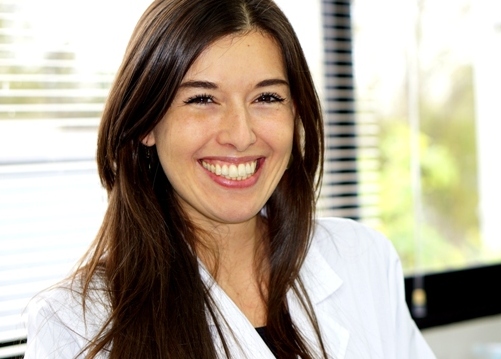Lorena has a degree in biochemistry (FFyB – UBA). She obtained a PhD in Chemistry (FCEyN – INQUIMAE – UBA) working on the functionalization of different surfaces with composite materials to develop electrochemical sensors. She carried out postdoctoral studies at the Soft Matter Laboratory of the Instituto de Investigaciones Fisicoquímicas Teóricas y Aplicadas (INIFTA) on charge transport in supramolecular films formed by polyelectrolyte-surfactant complexes. She also carried out teaching activities at the Universidad de Buenos Aires (FCEyN – INQUIMAE).
Currently, Lorena is a CONICET staff researcher at the Soft Matter Laboratory. Her research projects involve the design of functional macromolecular nanoarchitectures, in two main areas: the design, synthesis, and physicochemical characterization of nanoparticles and surfaces with different functional properties, applied to the controlled release of bioactive molecules, and the development of supramolecular materials and surface modification techniques for the manufacture and optimization of biosensors.
Research interest
Selected Publications
- “Solvent effects on the structure-property relationship of redox-active self-assembled nanoparticle-polyelectrolyte-surfactant composite thin films: Implications for the generation of bioelectrocatalytic signals in enzyme-containing assemblies”.
L. Cortez, M. Ceolín, J.L. Cuellar Camacho, E. Donath, S. Moya, F. Battaglini, O. Azzaroni.
ACS Applied Materials & Interfaces 9 (2017) 1119-1128. - “Formation of redox-active self-assembled polyelectrolyte-surfactant complexes integrating glucose oxidase on electrodes: Influence of the self-assembly solvent on the signal generation”
L. Cortez, M. Ceolín, O. Azzaroni, F. Battaglini
Bioelectrochemistry 105 (2015) 117–122. - “Effect of Gold Nanoparticles on the Structure and Electron Transfer Characteristics of Glucose Oxidase-Redox Polyelectrolyte-Surfactant Complexes”.
L. Cortez, W. Marmisollé, D. Pallarola, L.I. Pietrasanta, D.H. Murgida, M. Ceolín, O. Azzaroni, F. Battaglini.
Chemistry – A European Journal 20 (2014) 13366–13374. - “Hydrophobic interactions leading to a complex interplay between bioelectrocatalytic properties and multilayer meso-organization in layer-by-layer assemblies.”
L. Cortez, N. De Matteis, M. Ceolín, W. Knoll, F. Battaglini and O. Azzaroni
Physical Chemistry Chemical Physics 16 (2014) 20844-20855. - “Self-Assembled Redox Polyelectrolyte-Surfactant Complexes: Nanostructure and Electron Transfer Characteristics of Supramolecular Films with Built-In Electroactive Chemical Functions”
L. Cortez, G.A. González, M. Ceolín, O. Azzaroni, F. Battaglini.
Electrochimica Acta, 118 (2014) 124– 129. - “Electron Transfer Properties of Dual Self-Assembled Architectures Based on Specific Recognition and Electrostatic Driving Forces: Its Application to Control Substrate Inhibition in Horseradish Peroxidase-Based Sensors”
L.Cortez, D. Pallarola, M. Ceolín, O. Azzaroni, F. Battaglini.
Analytical Chemistry 85 (2013) 2414-2422. - “Electrochemical Sensing Platform Based on Polyelectrolyte-Surfactant Supramolecular Assemblies Incorporating Carbon Nanotubes”.
L. Cortez, M. Ceolín, O. Azzaroni, F. Battaglini.
Analytical Chemistry 83 (2011) 8011-8018.



